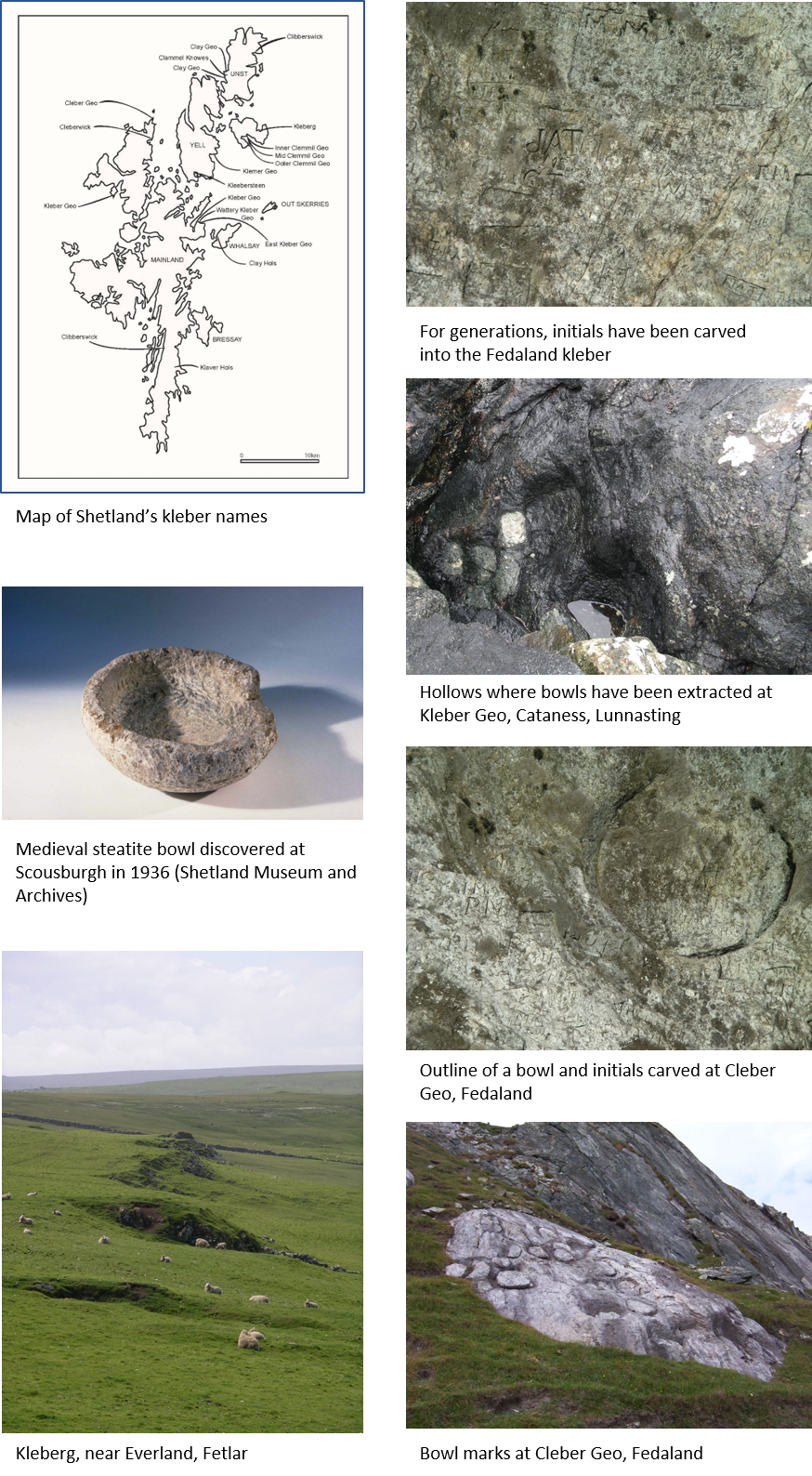Place-name of the week – kleber, klamel and klemel
Published: 21 May 2020
 In her latest Off the Beaten Track Blog (no 7, 15 May), my colleague Val Turner goes in search of Norse soapstone quarries. Many of these can only be identified by careful study of geological maps or through place-names - kleber, klamel and klemer (and a few klever) names all point us to outcrops of soapstone or steatite. Spellings and pronunciation vary, and Ordnance Survey maps use “c” instead of the initial “k”. The dialect word kleber comes from the Old Norse klébergi meaning loom weight stone, one of the original uses of steatite. Similar words occur in Norway, Denmark and Iceland.
In her latest Off the Beaten Track Blog (no 7, 15 May), my colleague Val Turner goes in search of Norse soapstone quarries. Many of these can only be identified by careful study of geological maps or through place-names - kleber, klamel and klemer (and a few klever) names all point us to outcrops of soapstone or steatite. Spellings and pronunciation vary, and Ordnance Survey maps use “c” instead of the initial “k”. The dialect word kleber comes from the Old Norse klébergi meaning loom weight stone, one of the original uses of steatite. Similar words occur in Norway, Denmark and Iceland.
Archaeological evidence shows that kleber was used in Shetland from prehistoric times. Its heyday was during the Viking and Norse periods, when steatite was extensively quarried to produce items both for local use and export. The high talc content combined with a low risk of shattering when heated meant the rock was ideal for making bowls, pots, lamps, loom weights and fishing weights. Other products included beads and bracelets, temper for pottery and, more recently, firebricks. At many sites you can clearly see the chisel marks and hollows where bowls have been extracted, together with the blanks of vessels that were never removed.
Cross Geos (Clibberswick, Unst), Cleber Geo (Fedaland) and Catpund (Cunningsburgh) are perhaps the largest and most well-known quarries. Talking to locals, studying geological maps and visiting sites have helped locate quarries at Clammel Knowes, Unst and Klaver Hols, Cunningsburgh. There is a Cleberwick in Lochend and in Yell, there once was a small deposit at Klemer Geo, Otterswick and a rock called Da Kleebersteen near Cuppaster.
The profusion of steatite in Unst includes outcrops at Burrafirth, Queyhouse, Da Westing (two Clay Geos), Uyeasound and Belmont, in addition to the quarries at Clibberswick and Clammel Knowes. In Fetlar the early form of the name is preserved at Kleberg, whilst there is evidence of workings at Daamins, Scarpi Geo, and the three Klemel Geos. In Lunnasting there are bowl markings and carved initials in the rock at Kleber Geo with two further small deposits at Wattery Kleber Geo and East Kleber Geo. Nearby the shape of vessels, still attached to the rock, are clearly visible at Orwick. The outcrop at Clibberswick, Wester Quarff can only be pinpointed by the name, having been missed by geologists when mapping the isles.
Early travel writers recorded other uses for kleber. Touring Shetland in 1774, Low records “Near Hilswick was shewn in the rock a large vein of a fattish kind of stone, called here Claber, used in many cases as a medicine, especially in excoriations of children, the small pox, &c.” A few years later, Neill (1806) records “Pieces of pure white steatite are frequently found on the shore: these, I Believe, the people call clemmil, and employ for drawing white lines on cloth or wood…The serpentine is called kleber by the natives who use it as an excellent substitute for metallic oxides in ointments.”
In the 1890s both John Spence and Jakob Jakobsen recorded the word berdel (bairdal) as an alternative to kleber. Do you know this word or have you ever made kleber fire bricks or carved your initials in the soft stone? Please share your stories and photos by emailing placenames@shetlandamenity.org.
Eileen Brooke-Freeman, Shetland Place Names expert, May 2020
We hope you have enjoyed this blog.  We rely on the generous support of our funders and supporters to continue our work on behalf of Shetland. Everything we do is about caring for Shetland's outstanding natural and cultural heritage on behalf of the community and for future generations. Donations are welcomed and are essential to our work.
We rely on the generous support of our funders and supporters to continue our work on behalf of Shetland. Everything we do is about caring for Shetland's outstanding natural and cultural heritage on behalf of the community and for future generations. Donations are welcomed and are essential to our work.

